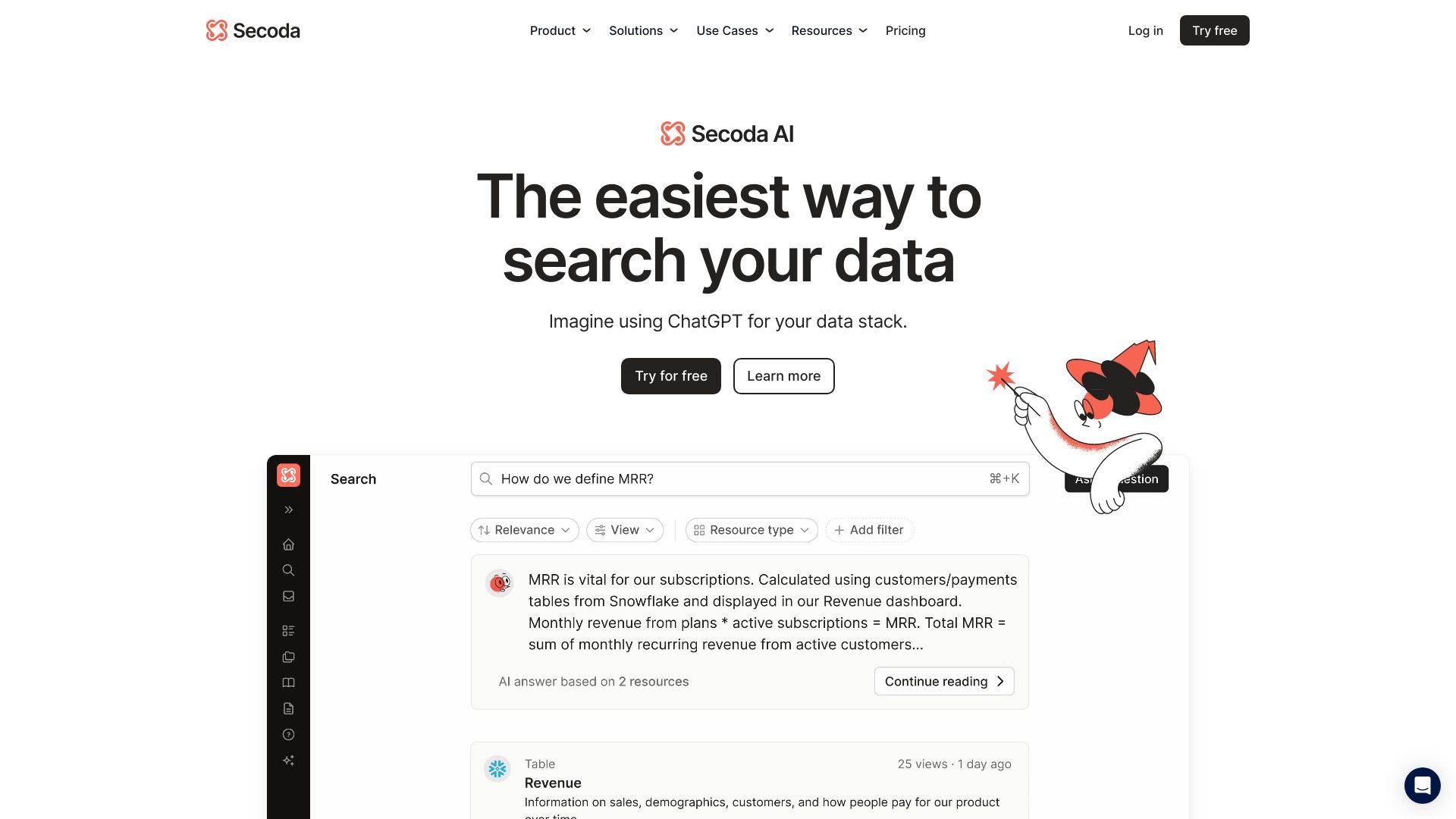- Home
- AI Developer Tools
- Secoda

Secoda
Open Website-
Tool Introduction:AI-ready data catalog and governance with lineage, quality, and access.
-
Inclusion Date:Nov 02, 2025
-
Social Media & Email:
Tool Information
What is Secoda AI
Secoda AI is a unified data governance and discovery platform that combines data cataloging, observability, lineage, and policy management in one AI-ready workspace. It centralizes metadata from warehouses, data lakes, BI tools, and pipelines to create a single source of truth for analytics. With natural language search and automated documentation, teams can quickly find trusted datasets, assess data quality, visualize impact, enforce access controls, and collaborate securely—without needing deep technical expertise.
Main Features of Secoda AI
- Unified data catalog: Centralizes metadata, documentation, and ownership to streamline data discovery and trust.
- End-to-end lineage: Visualizes how datasets, transformations, and dashboards connect for faster impact analysis.
- Data observability: Monitors data quality with checks, alerts, and SLAs to reduce broken pipelines and reporting errors.
- Governance and policy enforcement: Define and automate access policies, retention, and stewardship workflows.
- AI-assisted search and docs: Natural language search and automated documentation accelerate self-service analytics.
- Role-based access control (RBAC): Fine-grained permissions and secure access aligned to compliance needs.
- Collaboration tools: Requests, approvals, annotations, and ownership help operationalize data governance.
- Wide integrations: Connects to popular data warehouses, lakes, ETL/ELT tools, and BI platforms for seamless metadata ingestion.
- Glossary and business terms: Standardize definitions and metrics to reduce ambiguity across teams.
- Automation: Tagging, lineage enrichment, and policy workflows reduce manual catalog maintenance.
Who Can Use Secoda AI
Secoda AI supports data engineers, analysts, BI developers, data stewards, and governance teams who need reliable data discovery and data quality monitoring. It also helps product managers, compliance officers, and business leaders find trusted metrics, understand lineage, and request secure access. Organizations building self-service analytics, establishing a data mesh, or preparing for audits benefit from its unified approach to cataloging and governance.
How to Use Secoda AI
- Connect data sources and tools (warehouses, lakes, pipelines, BI) to ingest metadata and tags.
- Index and organize assets into a centralized data catalog with owners, domains, and business terms.
- Configure data lineage to visualize dependencies and enable impact analysis before making changes.
- Set up observability checks, SLAs, and alerts to monitor data quality and freshness.
- Define governance policies, RBAC, and approval workflows for secure access and compliance.
- Use natural language search to find datasets, read documentation, and assess trust signals.
- Collaborate with stakeholders via requests, annotations, and stewardship tasks to keep metadata current.
- Review audit logs and policy reports to track usage, access, and governance outcomes.
Secoda AI Use Cases
Centralize enterprise metadata for a single source of truth; enable self-service analytics with trusted datasets; automate access requests and policy enforcement; monitor data quality across pipelines; perform impact analysis during schema changes; standardize definitions for finance metrics; accelerate onboarding for new analysts; support compliance and audit readiness (e.g., GDPR, CCPA, SOX) with clear lineage, controls, and audit trails; and guide cloud modernization by mapping dependencies.
Secoda AI Pricing
Secoda AI offers tiered plans for teams and enterprises, with pricing that typically reflects seats, connectors, and governance features. Self-serve and custom options are available. For current plan details or to request a demo, visit the official website or contact the sales team.
Pros and Cons of Secoda AI
Pros:
- Unified platform for catalog, lineage, observability, and governance.
- AI-assisted search and documentation boost self-service adoption.
- Robust policy enforcement and RBAC for secure data access.
- Broad integrations with modern data stacks and BI tools.
- Clear lineage and impact analysis reduce breakages and rework.
- Collaboration workflows align stewards and business users.
Cons:
- Initial setup and metadata curation require stakeholder buy-in.
- Value depends on coverage and freshness of connected sources.
- Change management may be needed to standardize definitions and ownership.
- Advanced governance features may increase total cost at scale.
FAQs about Secoda AI
-
Does Secoda AI move my data?
It focuses on indexing and managing metadata, policies, and lineage rather than moving analytical data itself.
-
Can non-technical users benefit from Secoda AI?
Yes. Natural language search, clear documentation, and trust signals make data knowledge accessible to business users.
-
What integrations are supported?
Secoda AI connects to popular data warehouses, lakes, ETL/ELT platforms, and BI tools to aggregate metadata and lineage.
-
How does it help with compliance?
Through role-based access, policy workflows, audit logging, and lineage, it helps enforce controls and demonstrate governance.



